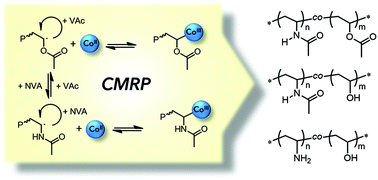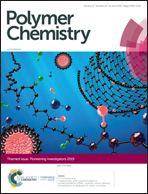Precision design of vinyl amine and vinyl alcohol-based copolymers via cobalt-mediated radical polymerization†
Abstract
Poly(vinyl alcohol) (PVA) and poly(vinyl amine) (PVAm) are major industrial polymers involved in countless applications taking advantage of their ability to establish hydrogen bonds and, for the latter, to create charges along the polymer's backbone upon protonation. Although combining vinyl alcohol and vinyl amine units in specific proportions within copolymers should allow precise tuning of their properties and enlarge the scope of their use, the controlled synthesis of poly(VAm-co-VA)s has been completely disregarded so far. In this context, we report a straightforward strategy for preparing the aforementioned copolymers via cobalt-mediated radical copolymerization of vinyl acetate (VAc) and vinyl acetamide (NVA) followed by hydrolysis. Copolymerization conditions were optimized to produce poly(NVA-co-VAc) with predictable molar mass, low dispersity and precise composition. Reactivity ratios were also determined to gain insight into the distribution of the amine and alcohol moieties along the backbone. Depending on the hydrolysis treatment applied to poly(NVA-co-VAc), unprecedented well-defined poly(VAm-co-VA)s and poly(NVA-co-VA)s were achieved via full deprotection of the precursor and selective hydrolysis of its esters, respectively.

- This article is part of the themed collection: Pioneering Investigators


 Please wait while we load your content...
Please wait while we load your content...